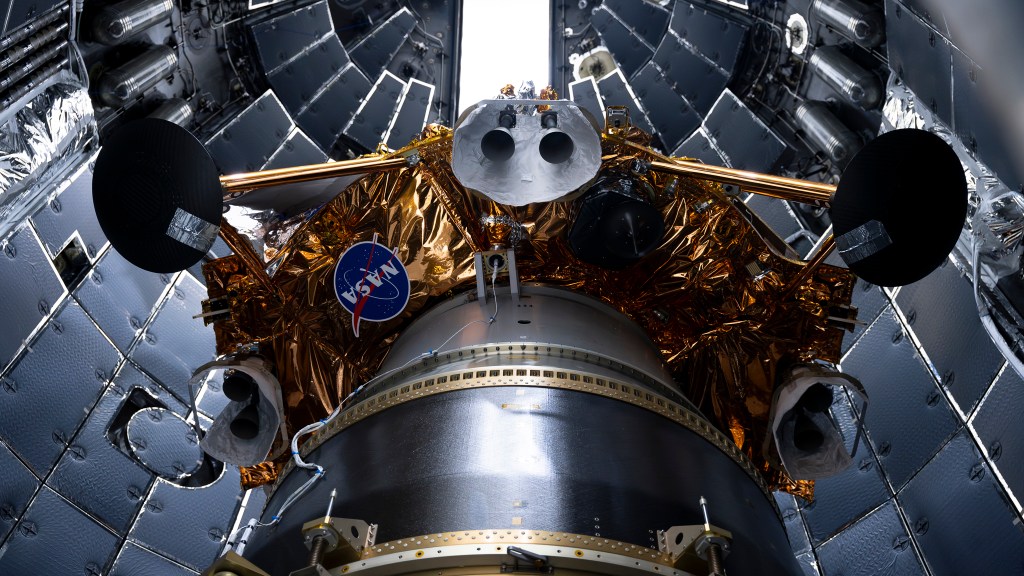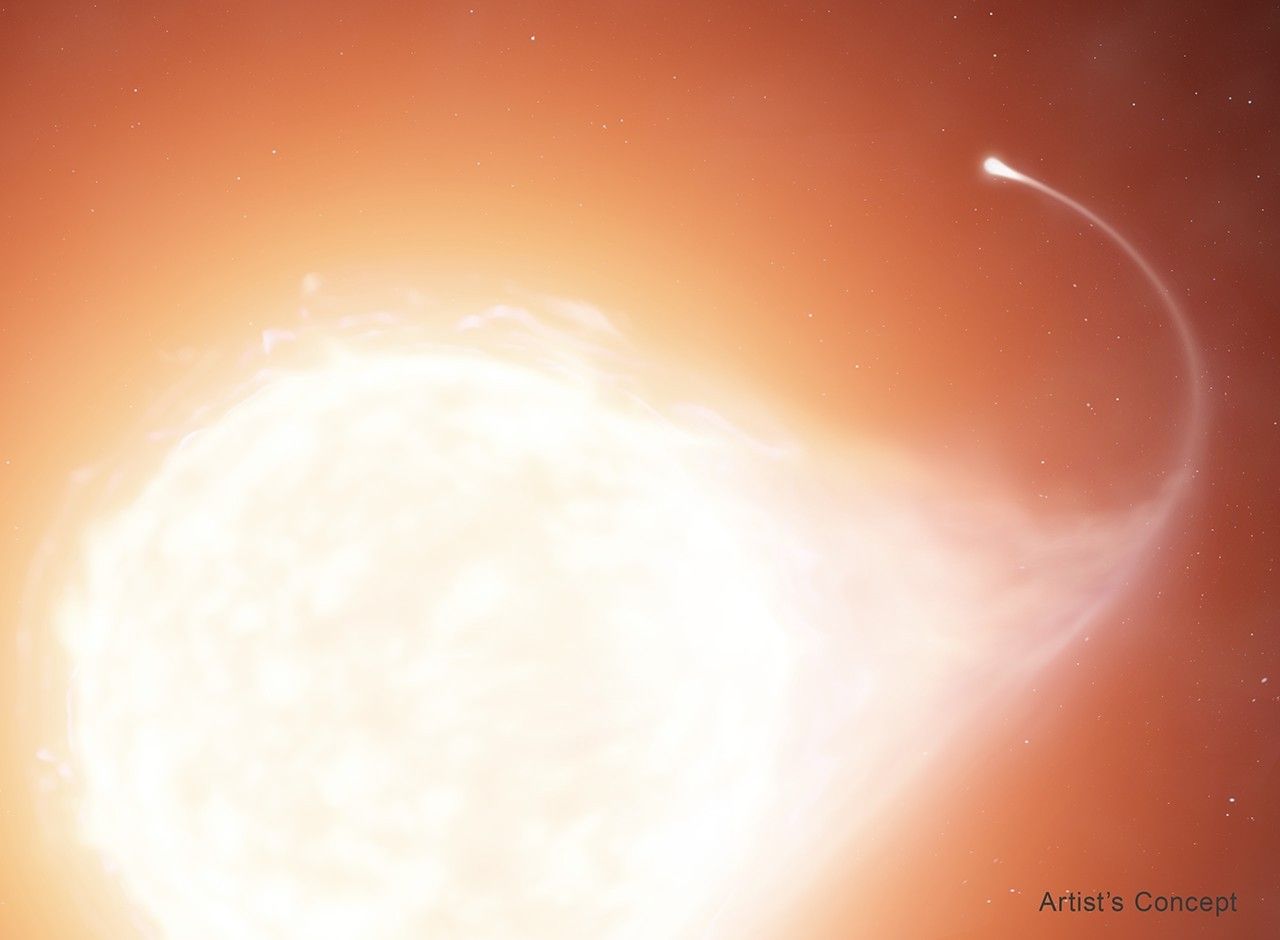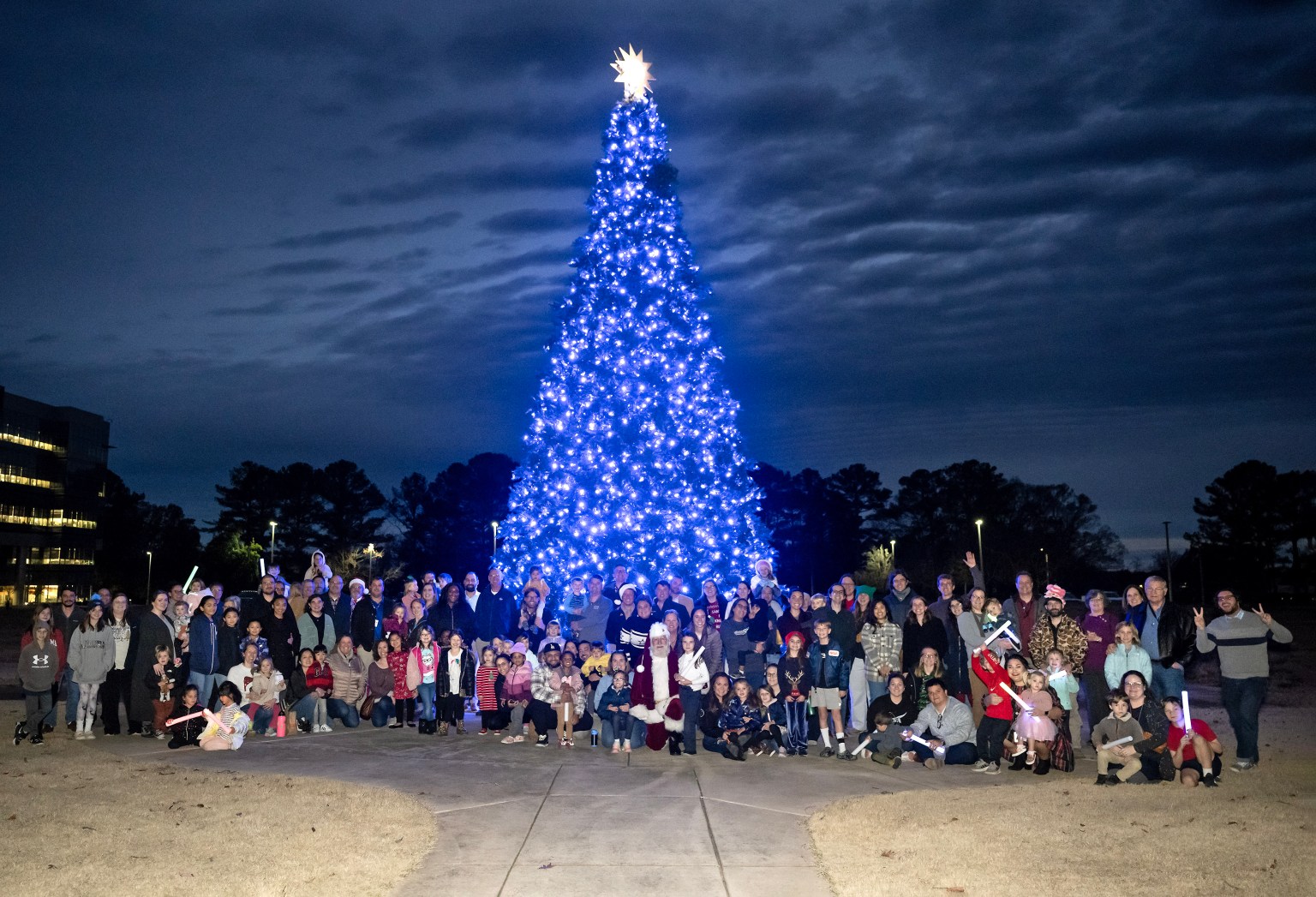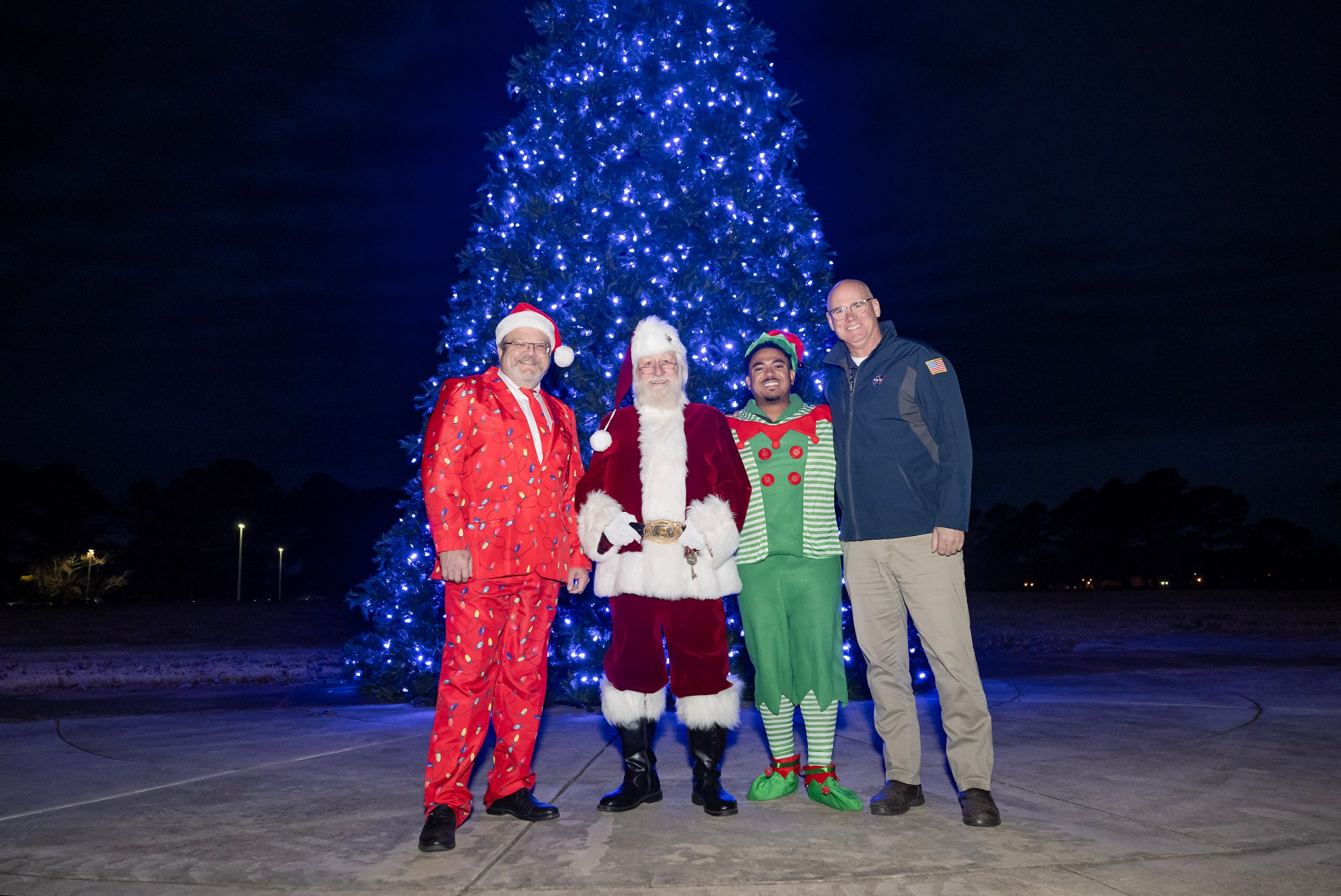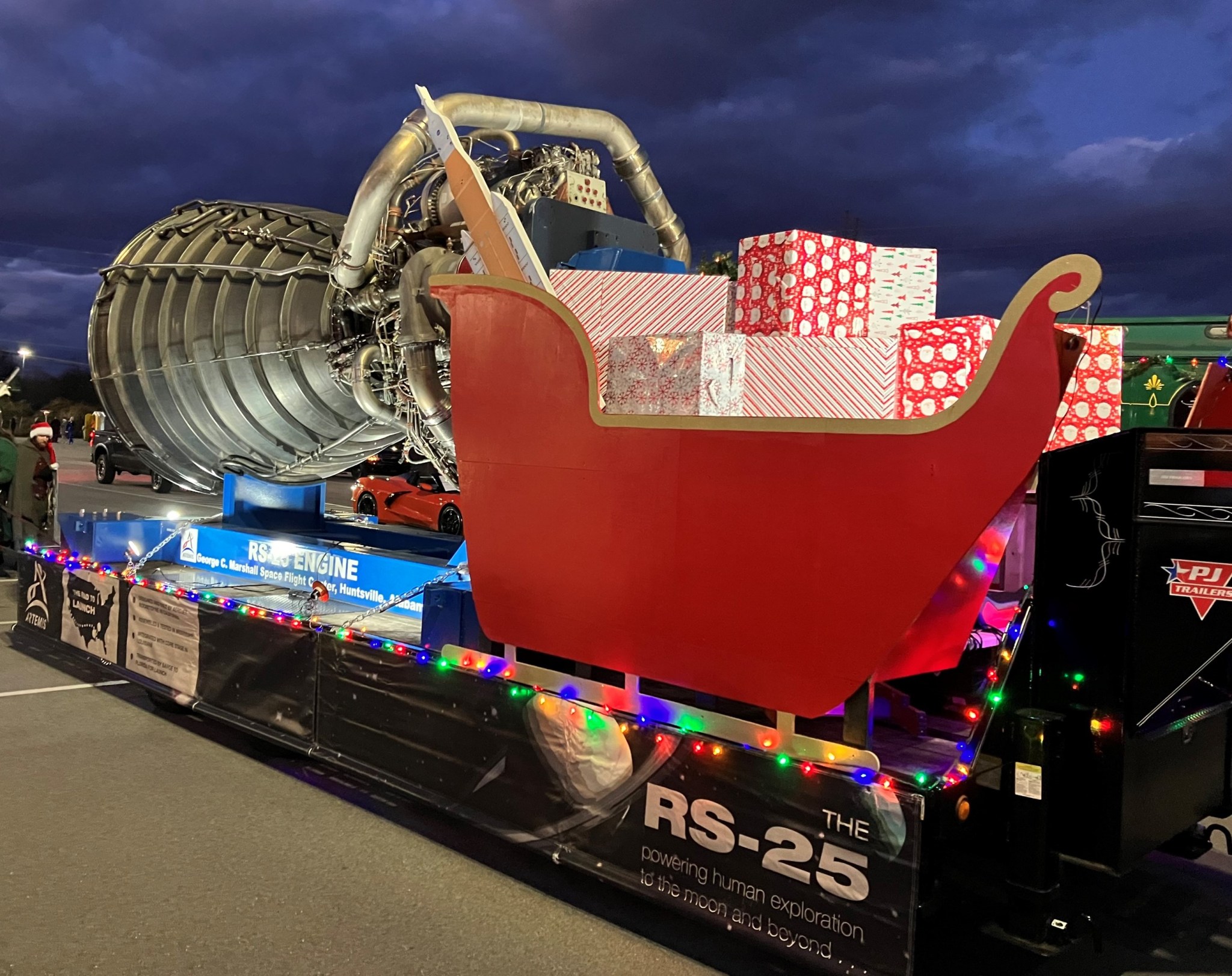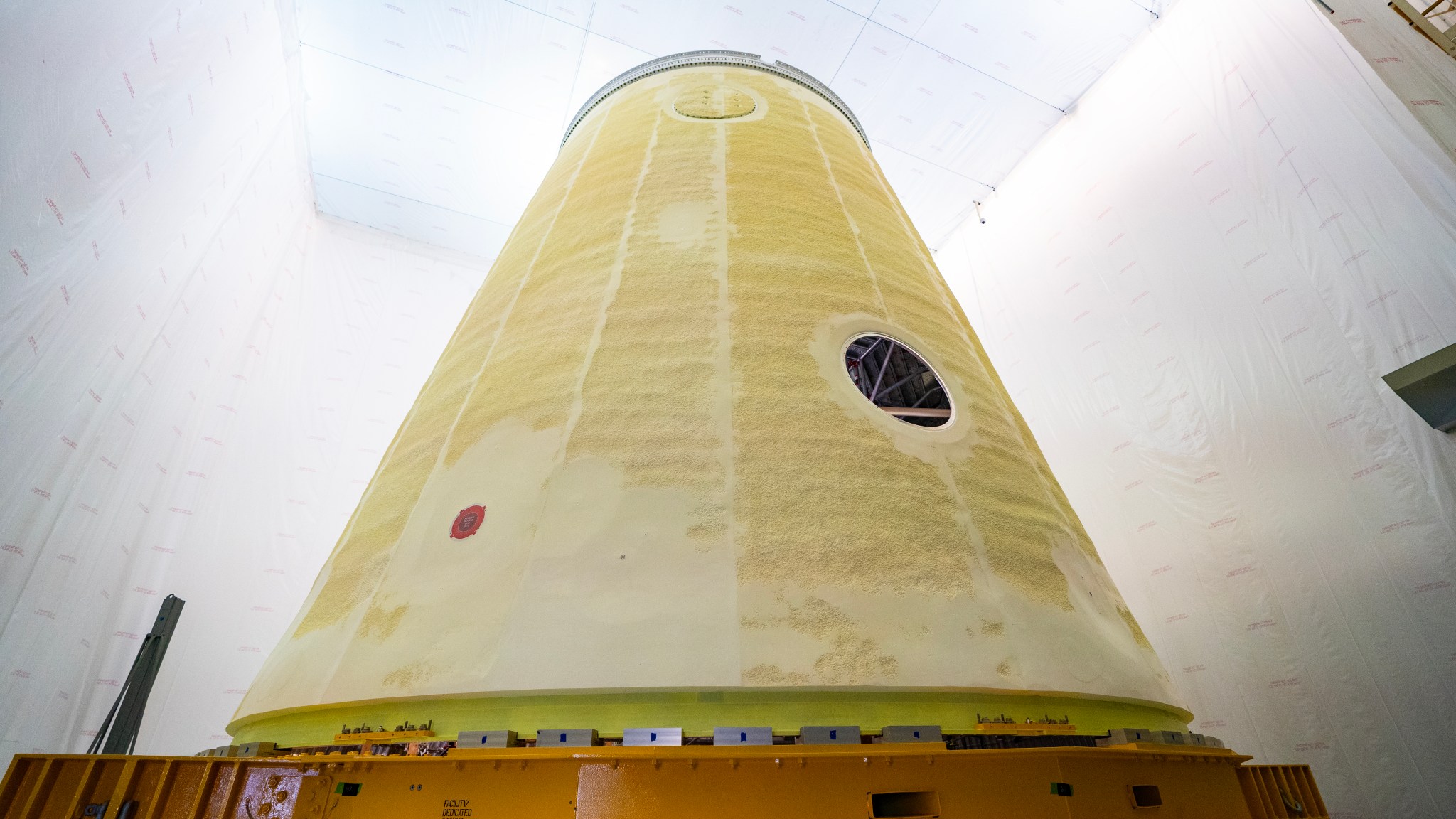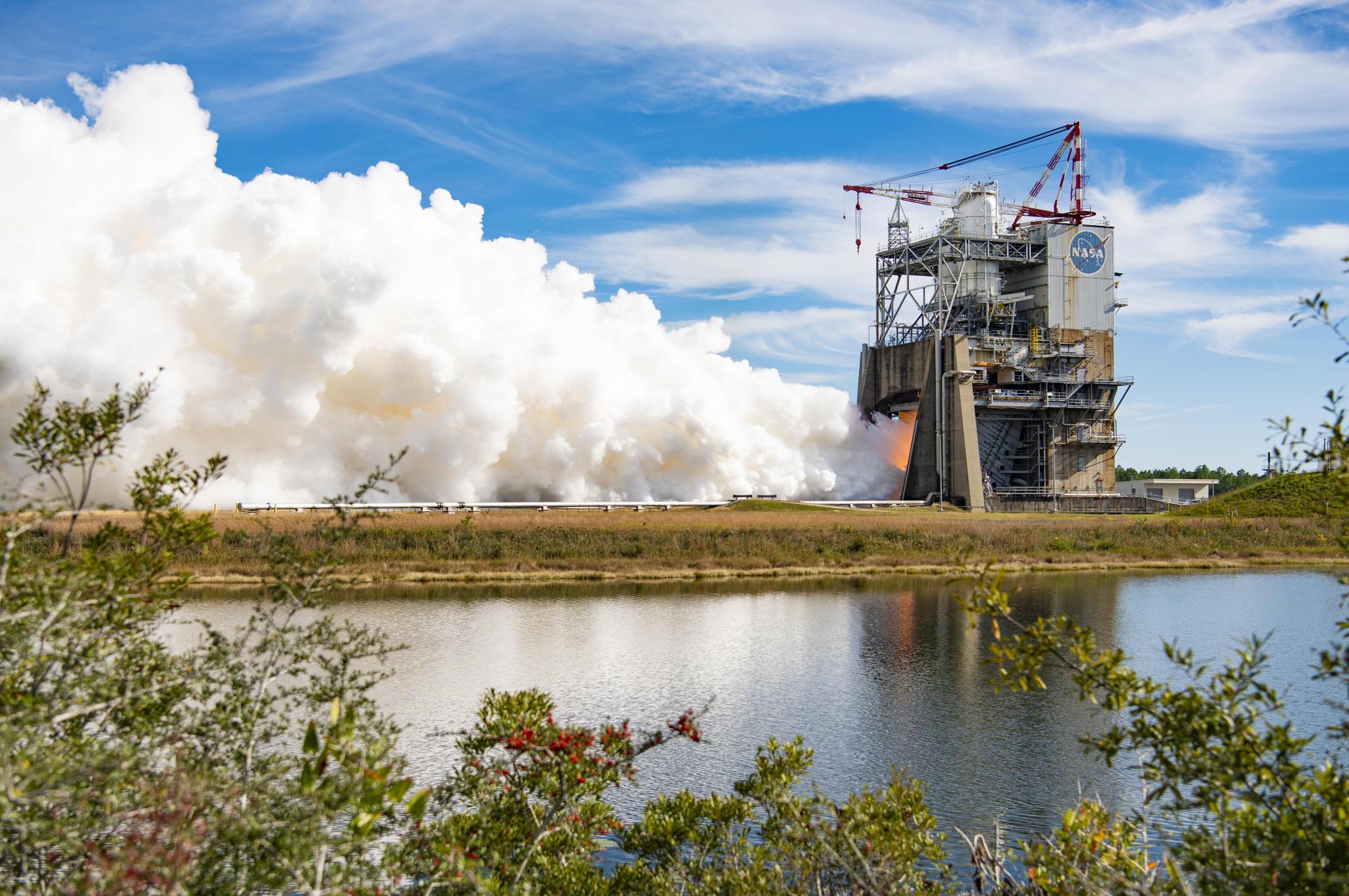Marshall Kicks Off Holiday Season with Tree-Lighting Ceremony
NASA’s Marshall Space Flight Center celebrated its annual tree-lighting ceremony in the courtyard of Building 4221 on Nov 30.
Marshall team members and their children gathered for the lighting of the 32-foot artificial tree decorated with blue lights and a 10-pointed star representing each NASA center.
Joseph Pelfrey, acting center director, opened the ceremony by welcoming team members and reflecting on some of the accomplishments at Marshall in 2023.

“On behalf of the entire leadership team, I want to thank you so much for all the hard work and the accomplishments we’ve had,” Pelfrey said. “The amazing missions we’ve worked will lead us to the future. We want to make sure that everybody has a great holiday season where everyone takes some time to rest for next year. It’s going to be a great year for Marshall and NASA.”
Marshall Team Members March in 9th Annual Huntsville Christmas Parade
By Celine Smith
Team members from NASA’s Marshall Space Flight Center came together to spread holiday cheer with thousands on Dec. 5 during the 9th annual Huntsville Christmas Parade.
The Marshall float displayed a test version of the RS-25 engine – the workhorse engine that powered the space shuttle for more than three decades and is now used to power NASA’s SLS (Space Launch System) rocket for Artemis missions. The engine was outfitted with a handmade Santa Claus sleigh full of Christmas presents, crafted by Marshall’s Model and Exhibits Shop.
Children wowed and cheered as the sleigh passed through the city streets. Marshall volunteers dressed in fun holiday gear walked alongside the float passing out candy and stickers to attendees.
The Marshall team was awarded third place for Best Float Design by the parade committee. Winning first place was the City of Huntsville Landscape Management, while second place went to the Ice Queen Alabama float.
“It’s amazing to see Huntsville’s growth through all the organizations that participated by making a float,” said Chad Emerson, grand marshal of the parade and managing director of Huntsville’s City Football Club.
The parade was presented by Bank Independent and hosted by radio station Mix 96.9, along with the VBC (Von Braun Center). This year, the parade’s theme was Christmas through the decades. More than 80 organizations decorated their floats to reflect Christmas in the past.
The parade had plenty of fun-filled activities for children in the VIP FunZone, sponsored by Lander’s McLarty Chevrolet. There, children took pictures with Santa Claus, met Elsa and Anna from Frozen, built gingerbread houses, and drank hot chocolate. The ticket also provided access to bleachers in the VBC’s Saturn Ballroom parking lot, where families could enjoy the parade. A donation of clothing for Kids to Love was all that was needed for tickets to the VIP FunZone.
Smith, a Media Fusion employee, supports the Marshall Office of Communications.
Julie Bassler Named Manager of Marshall’s Science and Technology Office
Julie Bassler has been named as the manager in the Science and Technology Office at NASA’s Marshall Space Flight Center, upon the retirement of Dave Burns at the end of December.
Bassler will lead the organization responsible for exploring planets, conducting science research, and developing new technologies. This includes creating and managing academic and industrial partnerships; managing and conducting basic scientific research, data science, and instrument development; managing technology development; hosting major agency programs in Planetary Missions and Technology Demonstration Mission offices; and operating science and technology projects.
Bassler has led numerous projects and programs during the past 34 years in support of NASA’s goals, which have spanned the areas of human space flight, robotic missions, science payloads, and technology developments.
Since 2018, Bassler has been the manager of the Stages Office of NASA’s SLS (Space Launch System) Program at Marshall. She led the SLS core stage team through the design, development, test, and successful inaugural launch of the 212-foot core stage on the Artemis 1 mission. Prior to that selection, Bassler was deputy element manager of the SLS Stages Office for five years and integration manager for one year.
In 2008, Bassler was named project manager for the International Lunar Network Anchor Nodes mission and the Robotic Lunar Lander Development Project in the Lunar Quest Program in the Science Mission Directorate at Marshall.
From 2006 to 2008, she was deputy program manager of the Lunar Precursor Robotic Program and supervisor of Marshall’s Lunar Precursor Robotic Office. In 2004, Bassler established and led Marshall’s first Technology and Capability Development Projects Office in support of the NASA Exploration Mission.
From 2002 to 2004, she was program manager of the International Space Station Materials Science Research Rack. Prior to that role, Bassler was business manager for all microgravity science racks and payload for the space station. She joined Marshall as a safety engineer for the space station in 1997 after working for several years at Johnson Space Center on both the International Space Station and Space Shuttle programs.
Her honors include a Meritorious Presidential Rank award, two NASA Outstanding Leadership Medals, Exceptional Achievement Medal, Space Flight Awareness award, Silver Achievement Medal, a Redstone Leadership Women Rocks award, and numerous other individual and group achievement awards.
A native of Breese, Illinois, Bassler received a bachelor’s degree in aerospace engineering from Parks College of St. Louis University in Cahokia, Illinois, and a master’s in space science from the University of Houston in Clear Lake, Texas.
She and her husband of 35 years, Brad, live in New Market. They have four children.
Six Finalists Advance in NASA’s $3.5 Million Lunar Regolith Challenge
By Savannah Bullard
The stage is set for the finale of NASA’s Break the Ice Lunar Challenge.
Conceived in 2020, Break the Ice tasked innovators with creating robotic systems that can traverse the volatile terrain of the Lunar South Pole. These robots must be able to dig into the Moon’s regolith – the dusty, icy “dirt” that makes up the lunar surface – and transport it to a secondary location for in-situ resource utilization processing.
If deployed on a NASA mission, these systems would operate in the permanently shadowed regions of the Moon, an area that receives no sunlight. These technologies must survive bitterly cold conditions and cannot rely on solar power regeneration. If successful, NASA can excavate the regolith from this area and use the resources derived from the materials, like frozen water, to aid astronauts living on the Moon.
“Our goal is to provide solutions to make living on the Moon a reality, and Break the Ice directly contributes to that mission,” said Denise Morris, program manager for NASA’s Centennial Challenges. “Excavating lunar regolith before humans arrive on the Moon will allow us to find uses for that material before they get there – if we could build a lunar habitat out of the regolith or extract the water for our astronauts to drink, that means less mass on our vehicles and less work for our crews.”
Phase 1 of the competition focused on designing systems that could achieve three components: excavation, travel, and delivery. Of the 31 teams who submitted eligible proposals, 13 won cash prizes ranging from $25,000 to $125,000.
Phase 2, Level 1 opened in June 2022. Consisting of Phase 1 winners and newcomers, 25 teams developed their initial designs into prototypes with technical reports, engineering designs, and test plans. Six months later, 13 U.S. semifinalists were named, each earning an equal share of $500,000. Two international teams were also recognized as semifinalists, though they were not eligible to receive monetary prizes from NASA.
In Phase 2, Level 2, the finalist pool comprised of garage inventors, academics, industry professionals, and hobbyists from 11 U.S. states, the Netherlands, and India. Nine of these teams attempted a 15-day demonstration trial at their own testing sites to prove the capabilities of their prototypes. The teams live-streamed the tests and took turns hosting representatives from Centennial Challenges for in-person observations.
“What impresses me the most with this batch of competitors is their innate ability to each find unique ways to approach the solution,” said Break the Ice Challenge Manager Naveen Vetcha, who supports Centennial Challenges through Jacobs Space Exploration Group. “Each site visit provided our subject matter experts with new ways to think about this technology and operations, and some of these teams expanded our expectations for how to bridge this technology gap.”
The Phase 2, Level 2 winning teams are:
- 1st place ($300,000): Starpath Robotics (San Francisco, California)
- 2nd place ($200,000): Terra Engineering (Gardena, California)
- 3rd place ($125,000): The Ice Diggers (Golden, Colorado)
Three teams finished as runners up ($75,000 each):
- Cislune Excavators (Los Angeles, California)
- Space Trajectory (Brookings, South Dakota)
- MTU Planetary Surface Technology Development Lab (Houghton, Michigan)
In this last round of competitions, scheduled to take place in the spring of 2024, the above winners will bring their prototypes to a NASA-designated test facility for a series of head-to-head matchups. Expected testing includes excavation under reduced gravity – using gravity off-loading – and transportation over complex terrain, including rocks, craters, slopes, turns, and loose granular soil.
“Bringing the competitors to one central location is the best way to end a challenge like Break the Ice because it provides us with an opportunity to observe and test their designs in a common relevant environment,” said Mark Hilburger, a senior research engineer in the Space Technology Exploration Directorate at NASA’s Langley Research Center and principal technologist for Break the Ice. “These technologies must be thoroughly tested to survive on the Moon, so a test opportunity like this helps the teams prove if their prototypes are up to the task.”
This final round of competition will offer up to $1.5 million in cash prizes, split between first place ($1 million) and second place ($500,000). NASA will also award opportunities for teams to test their concepts at one of the agency’s Thermal Vacuum Chambers, which can simulate the temperature and atmospheric pressure conditions at the Lunar South Pole.
The Break the Ice Lunar Challenge is a NASA Centennial Challenge led by the agency’s Marshall Space Flight Center with support from NASA’s Kennedy Space Center. Centennial Challenges are part of the Prizes, Challenges, and Crowdsourcing program led by NASA’s Space Technology Mission Directorate and managed at Marshall. Ensemble Consultancy supports the management of competitors for this challenge.
Bullard, a Manufacturing Technical Solutions employee, supports the Marshall Office of Communications.
New Course from NASA Helps Build Open, Inclusive Science Community
NASA released its free Open Science 101 curriculum Dec. 6 to empower researchers, early career scientists, and underrepresented communities with the knowledge and tools necessary to embrace open science practices.
The curriculum’s initial goal is to train 20,000 scientists and researchers over the next five years, enabling them to embrace open science practices and maximize the impact of their work.
“NASA is committed to ensuring people around the world have equal and open access to science data whenever they need it,” said NASA Administrator Bill Nelson. “This innovative curriculum will support the White House’s Year of Open Science to help people make informed, research-based decisions that will benefit humanity and improve life here on Earth.”
Developed by NASA’s Transform to Open Science initiative in collaboration with subject matter experts, the curriculum is designed to meet researchers at every stage of their open science journey – catering to those new to open science, established researchers, and aspiring students looking to embark on scientific careers. It also helps prepare researchers to incorporate required open science data management plans when applying for NASA grant funding.
“We believe education is a shared endeavor that can be achieved through community-driven learning,” said Nicola Fox, associate administrator, Science Mission Directorate at NASA Headquarters. “Our new curriculum is a testament to the incredible potential that emerges when open science experts from academia, industry, and government unite. With this initial rollout, we’re not just launching a course; we’re igniting a movement where learners actively shape the course’s trajectory.”
In its initial form, the Open Science 101 curriculum presents an introduction to the world of open science while also setting the stage for its continued evolution. It introduces learners to definitions, tools, and resources and provides valuable best practices throughout the scientific workflow. All five modules of the course are accessible through an open online platform, where participants can learn at their own pace. In addition to the platform, the modules will also be covered in virtual and in-person instructor-led training sessions.
To further support engagement and knowledge exchange, NASA has forged strategic partnerships with scientific associations, allowing open science to be taught during large annual meetings, special science team summer schools, and other events. These initiatives aim to create a dynamic learning environment where participants can interact with experts, ask questions, and explore the frontiers of open science. The diversity in learning options ensures that participants can choose the mode that best suits their learning style and schedule, optimizing the learning experience.
The Open Science 101 curriculum is accessible to all interested individuals, aligning with NASA’s commitment to inclusivity and promoting equitable access to scientific resources.
The TOPS Project Office is located at NASA’s Marshall Space Flight Center. The team at Marshall supports the TOPS project by providing project coordination, digital resources, and communications support for the duration of the project. The office complements existing TOPS activities led by the Chief Science Data Office, including ROSES elements, events, partnerships, and activities at NASA centers.
Visit Transform to Open Science to learn more, register for Open Science 101, and begin taking the curriculum.
NASA Continues Progress on Artemis III Rocket Adapter with Key Joint Installation
Engineers and technicians at NASA’s Marshall Space Flight Center recently installed a key component called the frangible joint assembly onto the adapter that connects the core stage to the upper part of NASA’s SLS (Space Launch System) rocket.
The cone-shaped stage adapter, called the launch vehicle stage adapter, will be part of the SLS mega rocket that will power NASA’s Artemis III mission to the Moon. The frangible joint sits atop the adapter and operates as a separation mechanism. The frangible joint is designed to break apart upon command, allowing the upper part of the rocket, NASA’s Orion spacecraft, and the crew inside Orion to quickly separate from the SLS core stage and adapter.
Frangible joint assemblies are widely used across the space industry in a variety of crewed and uncrewed spacecraft to efficiently separate fairings or stages during launch, during ascent, in orbit and during payload deployment. The stage adapter used for Artemis III is set to be the last of its kind as SLS evolves into a larger and more powerful configuration for future Artemis missions, beginning with Artemis IV. The adapter is fully assembled at Marshall by NASA and lead contractor Teledyne Brown, which is also based in Huntsville. Marshall manages the SLS Program.
SLS is part of NASA’s backbone for deep space exploration, along with Orion and the Gateway in orbit around the Moon, and commercial human landing systems. SLS is the only rocket that can send Orion, astronauts, and supplies to the Moon in a single launch.
NASA Tests In-Flight Capability of Artemis Moon Rocket Engine
NASA conducted the third RS-25 engine hot fire in a critical 12-test certification series Nov. 29, demonstrating a key capability necessary for flight of the SLS (Space Launch System) rocket during Artemis missions to the Moon and beyond.
NASA is conducting the series of tests to certify new manufacturing processes for producing RS-25 engines for future deep space missions, beginning with Artemis V. Aerojet Rocketdyne, an L3Harris Technologies Company and lead engines contractor for the SLS rocket, is incorporating new manufacturing techniques and processes, such as 3D printing, in production of new RS-25 engines.
Crews gimbaled, or pivoted, the RS-25 engine around a central point during the almost 11-minute (650 seconds) hot fire on the Fred Haise Test Stand at NASA’s Stennis Space Center. The gimbaling technique is used to control and stabilize SLS as it reaches orbit.
During the Nov. 29 test, operators also pushed the engine beyond any parameters it might experience during flight to provide a margin of operational safety. The 650-second test exceeded the 500 seconds RS-25 engines must operate to help power SLS to space. The RS-25 engine also was fired to 113% power level, exceeding the 111% level needed to lift SLS to orbit.
The ongoing series will stretch into 2024 as NASA continues its mission to return humans to the lunar surface to establish a long-term presence for scientific discovery and to prepare for human missions to Mars.
Four RS-25 engines fire simultaneously to generate a combined 1.6 million pounds of thrust at launch and 2 million pounds of thrust during ascent to help power each SLS flight. NASA and Aerojet Rocketdyne modified 16 holdover space shuttle main engines, all proven flightworthy at NASA Stennis, for Artemis missions I through IV.
Every new RS-25 engine that will help power SLS also will be tested at NASA Stennis. RS-25 tests at the site are conducted by a combined team of NASA, Aerojet Rocketdyne, and Syncom Space Services operators. Syncom Space Services is the prime contractor for Stennis facilities and operations.
NASA’s Marshall Space Flight Center manages the SLS Program.
Chandra Catches Spider Pulsars Destroying Nearby Stars
A group of dead stars known as “spider pulsars” are obliterating companion stars within their reach. Data from NASA’s Chandra X-ray Observatory of the globular cluster Omega Centauri is helping astronomers understand how these spider pulsars prey on their stellar companions.
A pulsar is the spinning dense core that remains after a massive star collapses into itself to form a neutron star. Rapidly rotating neutron stars can produce beams of radiation. Like a rotating lighthouse beam, the radiation can be observed as a powerful, pulsing source of radiation, or pulsar. Some pulsars spin around dozens to hundreds of times per second, and these are known as millisecond pulsars.

Spider pulsars are a special class of millisecond pulsars, and get their name for the damage they inflict on small companion stars in orbit around them. Through winds of energetic particles streaming out from the spider pulsars, the outer layers of the pulsar’s companion stars are methodically stripped away.
Astronomers recently discovered 18 millisecond pulsars in Omega Centauri – located about 17,700 light-years from Earth – using the Parkes and MeerKAT radio telescopes. A pair of astronomers from the University of Alberta in Canada then looked at Chandra data of Omega Centauri to see if any of the millisecond pulsars give off X-rays.
They found 11 millisecond pulsars emitting X-rays, and five of those were spider pulsars concentrated near the center of Omega Centauri. The researchers next combined the data of Omega Centauri with Chandra observations of 26 spider pulsars in 12 other globular clusters.
There are two varieties of spider pulsars based on the size of the star being destroyed. “Redback” spider pulsars are damaging companion stars weighing between a tenth and a half the mass of the Sun. Meanwhile, the “black widow” spider pulsars are damaging companion stars with less than 5 percent of the Sun’s mass.
The team found a clear difference between the two classes of spider pulsars, with the redbacks being brighter in X-rays than the black widows, confirming previous work. The team is the first to show a general correlation between X-ray brightness and companion mass for spider pulsars, with pulsars that produce more X-rays being paired with more massive companions. This gives clear evidence that the mass of the companion to spider pulsars influences the X-ray dose the star receives.
The X-rays detected by Chandra are mainly thought to be generated when the winds of particles flowing away from the pulsars collide with winds of matter blowing away from the companion stars and produce shock waves, similar to those produced by supersonic aircraft.

Spider pulsars are typically separated from their companions by only about one to 14 times the distance between the Earth and Moon. This close proximity – cosmically speaking – causes the energetic particles from the pulsars to be particularly damaging to their companion stars.
This finding agrees with theoretical models that scientists have developed. Because more massive stars produce a denser wind of particles, there is a stronger shock – producing brighter X-rays – when their wind collides with the particles from the pulsar. The proximity of the companion stars to their pulsars means the X-rays can cause significant damage to the stars, along with the pulsar’s wind.
Chandra’s sharp X-ray vision is crucial for studying millisecond pulsars in globular clusters because they often contain large numbers of X-ray sources in a small part of the sky, making it difficult to distinguish sources from each other. Several of the millisecond pulsars in Omega Centauri have other, unrelated X-ray sources only a few arc seconds away. (One arc second is the apparent size of a penny seen at a distance of 2.5 miles.)
The paper describing these results will be published in the December issue of the Monthly Notices of the Royal Astronomical Society, and a preprint of the accepted paper is available online. The authors of the paper are Jiaqi (Jake) Zhao and Craig Heinke, both from the University of Alberta in Canada.
NASA’s Marshall Space Flight Center manages the Chandra program. The Smithsonian Astrophysical Observatory’s Chandra X-ray Center controls science operations from Cambridge, Massachusetts, and flight operations from Burlington, Massachusetts.
Read more about Chandra.
Psyche Delivers First Images, Other Data
NASA’s Psyche spacecraft is on a roll. In the eight weeks since it left Earth on Oct. 13, the orbiter has performed one successful operation after another, powering on scientific instruments, streaming data toward home, and setting a deep-space record with its electric thrusters. The latest achievement: On Dec. 4, the mission turned on Psyche’s twin cameras and retrieved the first images – a milestone called “first light.”
Already 16 million miles from Earth, the spacecraft will arrive at its destination – the asteroid Psyche in the main asteroid belt between Mars and Jupiter – in 2029. The team wanted to test all of the science instruments early in the long journey to make sure they are working as intended, and to ensure there would be plenty of time to calibrate and adjust them as needed.
The imager instrument, which consists of a pair of identical cameras, captured a total of 68 images, all within a star field in the constellation Pisces. The imager team is using the data to verify proper commanding, telemetry analysis, and calibration of the images.
“These initial images are only a curtain-opener,” said Arizona State University’s Jim Bell, the Psyche imager instrument lead. “For the team that designed and operates this sophisticated instrument, first light is a thrill. We start checking out the cameras with star images like these, then in 2026 we’ll take test images of Mars during the spacecraft’s flyby. And finally, in 2029 we’ll get our most exciting images yet – of our target asteroid Psyche. We look forward to sharing all of these visuals with the public.”
The imager takes pictures through multiple color filters, all of which were tested in these initial observations. With the filters, the team will use photographs in wavelengths of light both visible and invisible to the human eye to help determine the composition of the metal-rich asteroid Psyche. The imager team will also use the data to create 3D maps of the asteroid to better understand its geology, which will give clues about Psyche’s history.
Earlier in the mission, in late October, the team powered on the magnetometer, which will provide crucial data to help determine how the asteroid formed. Evidence that the asteroid once had a magnetic field would be a strong indication that the body is a partial core of a planetesimal, a building block of an early planet. The information could help us better understand how our own planet formed.
Shortly after being powered on, the magnetometer gave scientists an unexpected gift: It detected a solar eruption, a common occurrence called a coronal mass ejection, where the Sun expels large quantities of magnetized plasma. Since then, the team has seen several of these events and will continue to monitor space weather as the spacecraft travels to the asteroid.
The good news is twofold. Data collected so far confirms that the magnetometer can precisely detect very small magnetic fields. It also confirms that the spacecraft is magnetically “quiet.” The electrical currents powering a probe of this size and complexity have the potential to generate magnetic fields that could interfere with science detections. Because Earth has its own powerful magnetic field, scientists obtained a much better measurement of the spacecraft magnetic field once it was in space.
On Nov. 8, amid all the work with the science instruments, the team fired up two of the four electric propulsion thrusters, setting a record: the first-ever use of Hall-effect thrusters in deep space. Until now, they’d been used only on spacecraft going as far as lunar orbit. By expelling charged atoms, or ions, of xenon gas, the ultra-efficient thrusters will propel the spacecraft to the asteroid (a 2.2-billion-mile journey) and help it maneuver in orbit.
Less than a week later, on Nov. 14, the technology demonstration built into the spacecraft, an experiment called Deep Space Optical Communications, or DSOC, set its own record. DSOC achieved first light by sending and receiving optical data from far beyond the Moon. The instrument beamed a near-infrared laser encoded with test data from nearly 10 million miles away – the farthest-ever demonstration of optical communications.
The Psyche team has also successfully powered on the gamma-ray detecting component of its third science instrument, the gamma-ray and neutron spectrometer. Next, the instrument’s neutron-detecting sensors will be turned on the week of Dec. 11. Together those capabilities will help the team determine the chemical elements that make up the asteroid’s surface material.
Arizona State University leads the Psyche mission. A division of Caltech, NASA’s JPL (Jet Propulsion Laboratory) is responsible for the mission’s overall management, system engineering, integration and test, and mission operations. Maxar Technologies in Palo Alto, California, provided the high-power solar electric propulsion spacecraft chassis. Arizona State leads the operations of the imager instrument, working in collaboration with Malin Space Science Systems in San Diego on the design, fabrication, and testing of the cameras.
JPL manages DSOC for the Technology Demonstration Missions program within NASA’s Space Technology Mission Directorate and the Space Communications and Navigation program within the Space Operations Mission Directorate.
Psyche is the 14th mission selected as part of NASA’s Discovery Program, managed by the agency’s Marshall Space Flight Center. NASA’s Launch Services Program, based at Kennedy, managed the launch service.
Read more about NASA’s Psyche mission.


